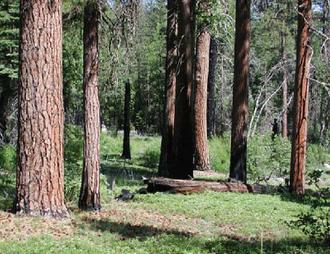 美國官方研究人員與民間學者最近的研究發現,目前優勝美地國家公園内直徑較大的樹木不如1932年多,而漸趨溫暖的氣候條件難脫其咎。直徑較大的樹木意指壽命最長,通常被稱為古木的樹木。
美國官方研究人員與民間學者最近的研究發現,目前優勝美地國家公園内直徑較大的樹木不如1932年多,而漸趨溫暖的氣候條件難脫其咎。直徑較大的樹木意指壽命最長,通常被稱為古木的樹木。
在該研究報告中政學家警告說,由於氣候暖化和樹種轉化為低耐火的傾向,優勝美地發生嚴重山林大火的機率將更加頻繁。
美國地質調查局(U.S. Geological Survey)和美國華盛頓大學的科學家,將早期1932年至1936年記載古木密度的資料與最近1988年至1999年的記錄相比。報告中記錄下在其中67年的時間裏,公園内的古木數量下降了24%的佐證。
優勝美地國家公園設立於1890年,並於1984年獲聯合國教科文組織指定為世界遺產。以公園内的花崗岩峭壁、瀑布、巨大的紅木林和生物多樣化而聞名。
但研究人員表示,公園内古木的數量減少意味著棲地喪失和可能面臨物種減少的窘境,包括斑點貓頭鷹、苔蘚、蘭花,以及稱為食魚貂(fisher)的哺乳類動物。儘管有這樣的名字,但食魚貂卻很少吃魚類。其學名為Martes pennanti,屬貂類,為肉食性的黃鼠狼科。
研究報告中作者解釋說,大樹的死亡率一般比小樹低,並且更能適應氣候變化。但這些揣測卻很少在長期性的追蹤研究中被檢視。
他們發現,古木密度以及生物多樣性減少最嚴重的情況發生在高海拔的林區類型。
從20世紀30年代到90年代間,優詩美地内古木密度下降了24%。儘管所有森林類型都出現古木明顯下降的跡象,然而減幅最嚴重的區域屬亞高山和高高山森林帶(佔公園面積的57%),而幅度最小的區塊則在低高山森林帶(佔公園面積的15.3%)。總的來說,他們發現11種古木的密度下降,只有3種古木數量呈現增加的現象。
科學家們還發現在近一個世紀來尚未經歷火災的森林中,出現朝低耐火樹種轉化的趨勢。這些區域裏,樹種由耐火的北美黃松轉向低耐火的白杉木和香柏木。而在燒山過的地區,松樹仍佔多數。
科學家們提醒道:「這種反差的現象突顯了重新將燒林整地的辦法納入森林管理的目標。」
There are fewer large-diameter trees in Yosemite National Park today than there were in 1932, and warmer climate conditions have played a role in this decline, new research by government and university scientists shows. Large diameter trees are those that have lived the longest, often called old-growth trees.
Their new research paper carries a warning that more frequent and severe wildfires are possible in Yosemite due to the warming climate and a shift to fire-intolerant tree species.
U.S. Geological Survey and University of Washington scientists compared the earliest records of large-diameter tree densities from 1932-1936 to the most recent records from 1988-1999. They documented a decline of 24 percent in the number of large-diameter trees in the park over this 67 year time period.
Created in 1890 and designated a UNESCO World Heritage Site in 1984, Yosemite National Park is known for its granite cliffs, waterfalls, giant sequoia groves and biological diversity.
But the researchers say a decline in the park's large trees means habitat loss and possible reduction in species such as spotted owls, mosses, and orchids as well as a mammal species known as fisher, which despite its name, seldom eats fish.
The fisher, Martes pennanti, is a marten, a carnivore in the weasel family. The authors explain in their paper that large trees generally have lower rates of mortality than small trees and are more resilient to climate change, but these assumptions have rarely been examined in long-term studies.
They found that large-diameter tree densities as well as diversity declined most in the more extensive higher elevation forest types.
Between the 1930s and 1990s, large-diameter tree density in Yosemite declined 24 percent. Although the decrease was apparent in all forest types, declines were greatest in subalpine and upper montane forests (57 percent of park area), and least in lower montane forests (15.3 percent of park area).
Large-diameter tree densities of 11 species declined while only three species increased, they found.
The scientists also found a shift to fire-intolerant trees in some forests that had not experienced fires for nearly a century. In these areas, trees changed from fire-tolerant ponderosa pines to fire-intolerant white fir and incense cedar. In burned areas, pines remained dominant.
"This contrast in composition reinforces the management objective of reintroducing fire to these forests," they advise.





